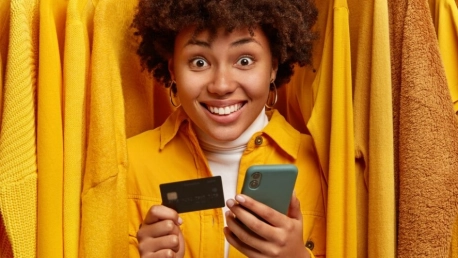The world of online retail has really opened up over the last ten years. From groceries and apparel, to furniture and collector’s items, anything and everything is up for grabs from the comfort of your home or the palm of your hand. Offering unprecedented convenience and ease, online retail shopping now accounts for 20% of all sales. Ease of use aside, what’s often missing from the context of conversation surrounding online retail is the darker side. With a constant influx of prompts and messaging, the urge to spend recklessly has never been greater, and disproportionately affects those with mental health issues. This is a tale of two realities, online shopping as both a blessing and a curse, for two very different vulnerable groups.
The Evolution of Online Shopping
With the rise of internet access and use, the world has completely transformed. We interact socially online, our workplaces are virtual, faith communities gather over the internet, and of course we shop online. In perfect lockstep with the proliferation of the internet, was the development of technology to facilitate these activities. Smartphones, tablets, and laptops were all part of the accelerated growth and adoption of technology at scale. With digital marketing and social media, the recipe for a fully online world was created.
Thanks to this, and a healthy nudge from COVID (we’ll get to this shortly), we’ve seen online retail really take off. Online marketplaces like eBay and Amazon are essentially virtual malls and department stores, housing thousands of retailers across a number of categories, giving shoppers a convenient one-stop shop.
In some ways, online marketplaces are actually better. If you decided to take up Padel, you could easily compare the cost of equipment across brands and retailers, and can factor in customer reviews when making your decision. When you factor in the additional costs of shipping, and the safety of online purchases, many prefer the convenience and safety bigger marketplaces offer.
With the introduction of mobile friendly online shopping, we took a few steps forward. We can now shop anywhere, anytime, from anywhere in the world. With mobile shopping and its integration with social media came new trends in engagement. Push notifications remind us about our abandoned carts, alert us when something we like is on sale, and offer us gifts to lure us back into their online stores.
The Covid Effect
E-commerce experienced exponential growth during COVID. With stay-home orders and lockdown restrictions preventing in-store shopping, the rise of online retail was inevitable.
Online Shopping: A Blessing for the Physically Disabled
The story of 72-year-old Jane Snowball and the Gateshead Council in the UK has long been relegated to the dusty annals of history, yet their contribution is really the origin story of online shopping. Already a senior citizen, and struggling with mobility, Jane found it difficult to do most things, including her shopping. The Gateshead Council partnered with their local grocery store, Tesco, and Videotex was born. All the way back in May 1984, Jane Snowball picked up her television remote, and ordered eggs, margarine, and cornflakes. The world’s first online order. The origins of online shopping was always meant to be a solution to promote inclusivity, providing viable options of ease and convenience to people who need it most. In the almost 40 years that have since passed, online shipping has exploded into an industry exceeding $5.7 trillion, and provides services for an estimated 274 million people in the U.S. alone.
For the physically disabled, or those who experience chronic pain, going in-store for purchases can be a challenge. It’s an altogether stressful experience, with challenges littered throughout the retail journey. For those with walking aides or wheelchairs, the aisles are often too narrow to navigate, while goods can be both too high up and too low down to reach. The same is true of clothing stores; the rack height can make it difficult for wheelchair bound shoppers to reach goods.
Added to this, retail workers, who provide an essential service in assisting the physically disabled, are quitting at an alarming rate. With such widespread discrimination, it comes as no surprise that people with disabilities use online shopping twice as much as any other group. For those with visual impairments, text-to-speech assistive technology provides descriptions of products, anyone struggling with dyslexia or learning challenges can make use of the visuals, and for those with mobility challenges, the ease of having products delivered direct to their homes provides comfort and convenience, and enhances quality of life and independence.
Quick Facts about Physical Disabilities and Online Shopping
- 36% of people with disabilities will continue using an online shopping platform if it’s accessible, even if the prices are higher
- 33% of users that have accessibility needs prefer using their smartphone as a device for online shopping
- 56% of disabled users choose an e-commerce retailer based on the site’s accessibility features
- 80% of disabled shoppers use Amazon as their preferred online marketplace
- In terms of accessibility issues, 81% of respondents in a survey said they experience accessibility issues when shopping online, but not enough to prevent a purchase
Reckless Spending and Mental Health
The Money and Mental Health Policy Institute (MMHPI) plays a leading role in advocating for and highlighting the tenuous relationship between mental health and spending habits. The “Convenience at a cost” report is a key piece of research that shows the vulnerability of those with mental health challenges to the worst aspects of online shopping; the barrage of push notifications, emails, and advertisements that constantly nudge consumers toward spending.
Their research indicates that 29% of people who have recently experienced a mental health challenge have spent more than they could afford while online shopping. This is more than double the rate of people who’ve overspent on online shopping without experiencing mental health challenges (12%). While we will explore the negative effects of this, it’s important to also note that online retail offers a number of positives for people experiencing mental health issues. Mental health is often invisible, and so the difficulties people face are often braved in silence. For consumers who experience paranoia and anxiety, or are overstimulated by large crowds and loud noises, the ability to get the necessities, and the luxuries, delivered to the sanctuary of their home is a gift. But the other side of this paints a very different picture. The “Convenience at a cost” report, points to three structural issues that it uncovered as catalysts for reckless spending.
1. A frictionless experienceRespondents that participated in the MMHPI survey highlighted ease of use as one of the contributing factors to poor spending habits on online shopping sites. Most sites allow for card details to be stored, and if not, there’s Google Pay, Apple Pay and a number of other device-specific payment gateway options provided. And in the cases where card details are not on hand, “Buy Now Pay Later” offers are readily available, exacerbating debt cycles for those who couldn’t afford a purchase in the first place. Survey respondents said that the frictionless experience was a driver for spending precisely because it didn’t feel like “real” money was being spent, a feeling that’s heightened during periods of poor mental health. According to the research, 54% of respondents (people who recently experienced a mental health challenge) indicated that online shopping makes it easy to spend more money than they can afford. 2. The constant pressure to buyWith advances in digital marketing, the urge to buy is all around us. We get push notifications from apps that alert us when a product we spent a little too long looking at foes on sale, we’re reminded that we abandoned a cart on our favorite website, and anything we Google comes up as ads no matter what app or site we use. It’s an inescapable onslaught of a single, urgent message: buy, buy, buy. Survey participants explained that this new wave of marketing has been a challenge to ignore, particularly when compounded with mental health issues; it sends their brains into panic-mode, altering decision-making and increasing sales.
3. Personalization drives purchases
In a similar vein, the hyper-personal experience of online shopping can be a huge driver of irrational purchases. This point also speaks to the ubiquity of ads and reminders, but also something far deeper; the inclusion of your name in email ads, the curation of a cocktail of ads that almost mimics your thoughts; what to some may be an inconvenient after-effect of online “window” shopping, is to others an invasive experience that compels them to spend at their lowest moments. As one of the respondents said, “online shopping is invaluable but overly invasive. We wouldn’t allow a sales assistant to follow us home and keep bombarding us with products and offers, and the online experience should not facilitate this.”
Quick Facts about Money and Mental Health
- 26% of people experiencing mental health illness felt an increased helplessness over spending during lockdown
- 47% of people who recently experienced a mental health problem said they purchased an item they didn’t need or use
- 61% of respondents prefer shopping online to going in-store
- 59% of respondents felt shopping online was more useful during periods of poor mental health
Retailer Recommendations to Reduce Harm
The Money and Mental Health Policy Institute have outlined a number of recommendations aimed at reducing harm for people experiencing mental health issues. These recommendations follow a consultative process with the people who are most affected, those with mental health illnesses.
One of the first areas to tackle is control over user accounts. 90% of respondents supported the idea of introducing greater control over certain elements used to drive sales, such as product recommendations or “buy now pay later” options. Being able to disable these features can go a long way in helping people control their spending. Increasing friction is another strategy to protect vulnerable online users. In this regard, 95% of respondents agreed that even a 24hr cooling period would be valuable in preventing compulsive spending.
Additionally, in keeping with responsible shopping parameters, respondents indicated that a prompt before purchases would be helpful, especially with the option to personalize it. Different people are compelled to spend money for different reasons, either depressive lows or manic highs, which is why customizable prompts could be helpful.
The Money and Mental Health Policy Institute advocate for a safe and responsible online shopping world, inspired by the strides taken by government and online gambling vendors, who have worked together to create a more conscious and considerate online environment.
Conclusion
The world of online shopping and e-commerce has come a long way since Jane Snowball first purchased cornflakes, margarine, and eggs through her TV screen. A trillion-dollar industry, online shopping has come a long way, and it’s been both a blessing and a curse for different groups.
For the physically disabled, while there’s certainly more to be explored in accessibility, it provides a spectrum of independence. On the other hand, online shopping can exacerbate reckless spending that is characteristic of certain mental health illnesses. The very nature of online shopping and digital marketing can drive unnecessary purchases, with hyper-personalized content curation, email prompts, push notifications, and targeted ads.
There’s still a lot to be done to create a responsible, safer online shopping environment for all. What is evident is that the online shops committed to creating an inclusive online retail experience for all will benefit from the trust and loyalty of all their customers.









